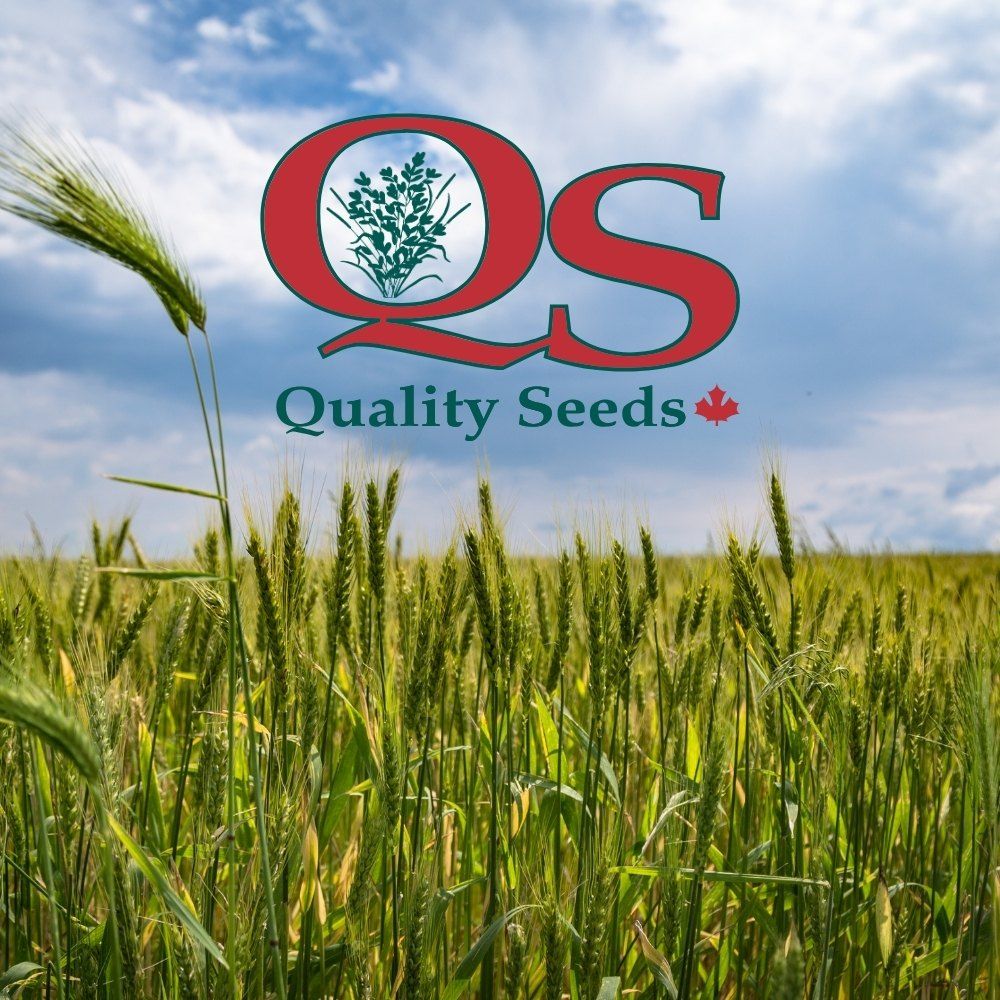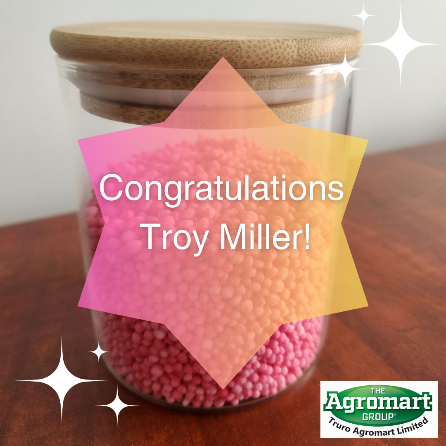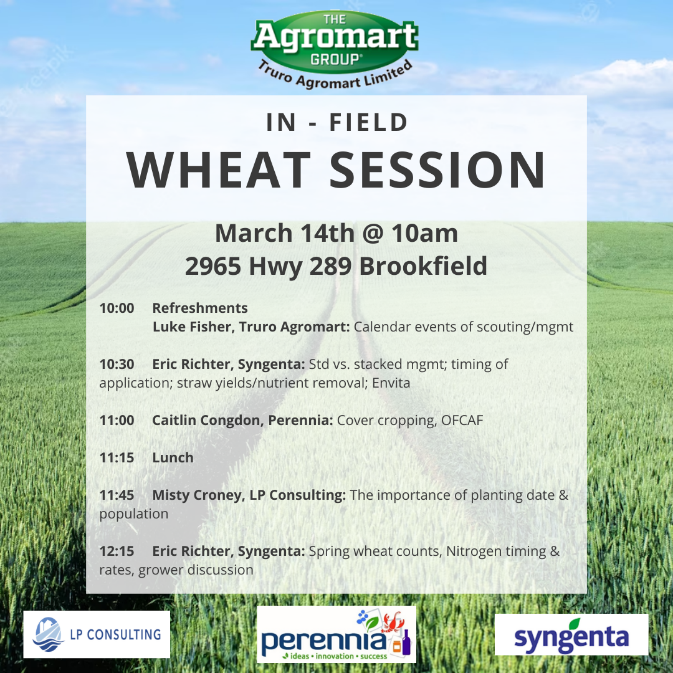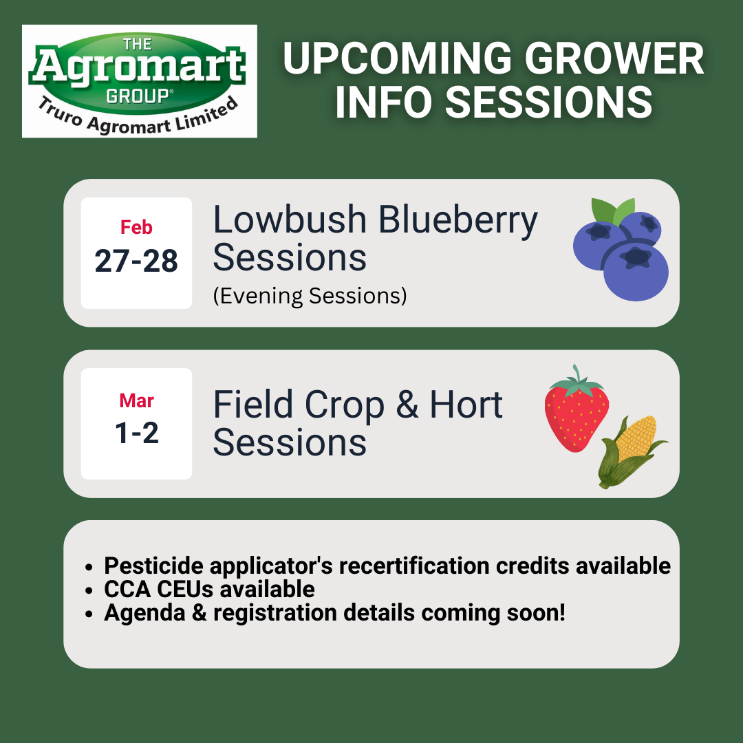High Quality Winter Triticale Forage
by Joel Bagg, Forage Development Specialist & District Sales Manager, Quality Seeds Ltd
Winter triticale has recently become a popular high quality dairy forage. It provides an opportunity as a “double crop” forage option when seeded after late-summer or early-fall harvested crops. To be successful, it requires excellent agronomic and harvest management. For optimum forage quality, it must be harvested at the “flag-leaf” stage in mid-May. When managed correctly, in addition to providing extra forage yield, forage quality can be exceptional, with extremely high fibre digestibility and decent crude protein. As a winter annual, it provides living cover crop benefits, including weed suppression and erosion control. To be most successful, close attention must be made to seeding at optimal seeding dates in September, nitrogen and sulphur fertilization, and harvest at the flag-leaf stage.
After harvest winter triticale can be followed by planting corn silage, soybeans, sorghum-sudan, or sudangrass, While it is most commonly followed by corn silage, and soybeans work well if it fits in the rotation, winter triticale also provides a good opportunity to double crop forage by planting SS2 BMR sudangrass (sometimes underseeded to alfalfa-grass) in late-May or early June.
Winter triticale forage is most popular on larger dairy farms (with the capacity to harvest quickly), with high corn silage rations (they compliment each other well in the crop rotation as well as the ration), in higher CHU areas (where it is easier to double-crop) and in areas where land is expensive and more difficult to rent (increasing forage yield per acre).
Winter Triticale Or Fall Rye?
Winter cereals include fall rye, winter triticale and winter wheat. Triticale is a hybrid cross between rye and wheat, and is intermediate in characteristics. Do not confuse fall rye (a cereal) with ryegrass (annual, Italian, perennial), as they are totally different grass species with quite different characteristics.
Fall rye is the earliest in maturity of the winter cereals, followed by triticale and then wheat. Winter wheat has the lowest yield potential for forage, and is generally not used. Winter wheat also heads two weeks later than fall rye making forage wheat harvest too late to be followed by corn or soybeans. Fall rye typically reaches the flag-leaf stage about a week earlier than
triticale. Fall rye matures the most rapidly at the flag-leaf, boot and early-heading stages, with very fast growth with significant reductions in forage quality. This can create the challenge of a very narrow harvest window, particularly if there are rain delays. Because of its later and slower rate of maturity, triticale provides a wider harvest window for quality forage. Depending on the weather forecast, it is better to harvest too early than too late. On the down side, the delayed harvest of triticale also means planting the following corn silage crop is also delayed, but this is less of an issue with soybeans, or sorghums and sudangrass (where there is little yield loss from late-May planting). Fall rye tends to grow taller, but with less tillering (resulting in a taller, thinner stand at the same seeding rate.) Fall rye may sometimes be more winterhardy where management is less than ideal (such as late planting), but can also have an increased risk of lodging over winter triticale, especially with high nitrogen application rates.
Quality Seeds “Infiniti” and “XTR” Brand Winter Triticale
Quality Seeds offers Brands of winter triticale – Infiniti and XTR, as our best recommended winter forage options. They are each blends of two improved triticale varieties that provide a combination of high forage yield and forage quality. Disease resistance and winter survival are excellent. We have marketed XTR for a few years with excellent results, but after recent field trial plot research we have introduced the new Infiniti Brand, which shows increased yields, increased milk per acre, high leaf to stem ratio and extended harvest window.
There are differences in yield potential, maturities and forage quality between triticale varieties. With common seed you will be uncertain of those varietal characteristics, so it is important to buy a trusted brand.
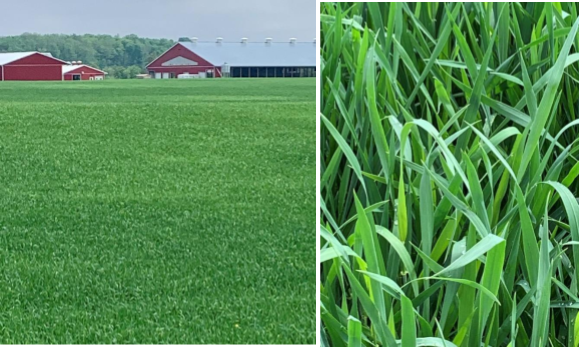
XTR Brand Triticale, Riverdown Holsteins, Osgoode
Seeding Dates
Winter triticale is easy to establish and can be seeded from late-summer to early-fall. However, research by Tom Kilcer in New York suggests the optimum time for high forage yields of triticale is 10 – 14 days earlier than the optimum planting dates for wheat-for-grain in a specific area. Refer to Figure 1 – www.gocereals.ca/OptimumPlantingDate-WinterWheat_colour_final.pdf. For wheat-for grain, optimum planting dates ranges from about mid-September in the lower CHU areas of southern Ontario, to the second week of October in Kent-Essex in the south-west. The optimum time to plant triticale for maximum forage yields will be 10-14 days before these dates.
An early planting date allows more time for plant tillering and a thicker stand, which increases the spring forage yield potential, and can help smother winter annual and biennial weeds. Earlier planting dates also enable slightly earlier forage harvest dates. Later plantings with less root growth are more susceptible to spring heaving and injury. Later plantings can still work, but with reduced yield potential and increased risk of winter injury. Note that it is often difficult to plant triticale at the “optimum time” following corn silage harvest, especially in lower CHU areas.
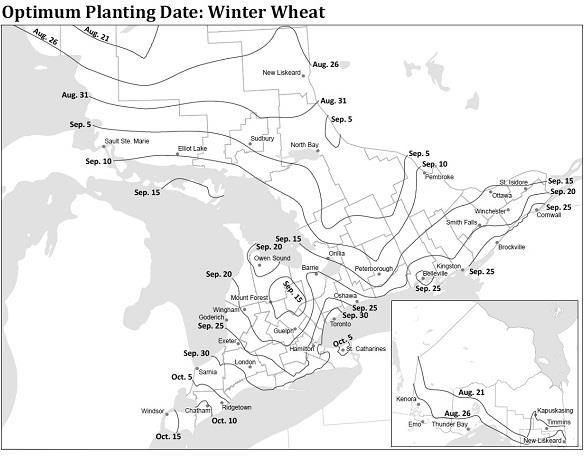
Figure 1 – Wheat-For-Grain Optimum Planting Dates (OMAFRA). Optimum planting dates for triticale are 10 – 14 days earlier.
Seeding Rates & Seeding Depth
Under good conditions with early seeding, winter triticale should be seeded at 100 lbs/ac. It is recommended to drill seed at a depth of 1-1/4 to 1-1/2 inch deep. A firm, well- prepared
seedbed is important for an optimal, uniform stand. Shallow plantings have a less developed root system that are more prone to early spring heaving, injury or winterkill. This is especially the case with later plantings. Broadcast seeding will result in significantly reduced yields. Avoid poorly drained, heavier soils.
Fertility
Some fall applied N increases tillering that increases spring yield. A fall N rate of up to 40 – 50 lbs/acre is suggested for early planted crops. Late planted crops have limited ability to use any N and it is not likely economical. Pre-plant, incorporated liquid manure can provide fall N, but application should not significantly delay planting date.
An additional 100 lbs of N should be applied at early green-up in the spring for increased yield and significantly higher crude protein (CP). A rule of thumb is that grasses require 45 lbs N per tonne of expected dry matter yield.
Consider sulphur (S) requirements by including a spring ammonium-sulphate application to improve yields and % CP, where manure was not applied in the fall. A suggested amount is 1 lb of S for every 10 lbs of N.
Removal rates of P and K are similar to other forages at about 14 lbs of P2O5 and 55 lbs of K2O per tonne of dry matter.
Harvesting At the Flag-Leaf Stage
The timing of cutting is critical to forage quality. Digestibility, crude protein, palatability, and intake drop very quickly at the heading stage, so the optimum harvest window is very narrow. It is recommended to target harvesting at the flag-leaf stage (Growth Stage 39) for high nutrient quality. Depending on temperature, moisture and variety, the flag-leaf harvest window can be very tight (maybe 5-7 days). There can be a very large range in forage quality with only a few days difference in harvest. To understand how to anticipate and recognize this stage, refer to Winter Wheat Staging at https://gfo.ca/wp-content/uploads/2023/02/Grain-Farmers-of-Ontario-Cereal-Staging-Guide-223on_compressed.pdf . Watch for the seed head still within the stem moving up to emerge at the boot-stage.
Yield & Quality Expectations
Winter triticale is usually harvested and stored as haylage, but could be stored as baleage. Triticale can often be difficult to wilt to appropriate silage moisture. Wide swath can help.
There is a wide variation in yields between areas (CHUs) and management. Rotational difficulties that delay planting past optimal dates can significantly reduce yield potential in some areas. Dry matter yields are often reported in the 2 – 2.5 tonnes per acre when harvested at the flag-leaf stage , but with excellent management (optimal early seeding date, proper N and S fertility) , the yield potential can be higher.
At the flag-leaf stage CP levels of 16% are common, but with proper fertility management (N and S), they can exceed 18%. At this stage, NDF levels can be under 50%, while sugar levels, fibre digestibility (NDFD30 approaching 70’s), and rates of digestion are high.
At the head-emerged stage (Growth Stage 55), CP drops to the 13 – 14% range, while NDF increases to over 60% and fibre digestibility drops significantly. This will likely be adequate for beef cows, heifers, and dry cows, but will not be high producing dairy cow quality.
When cut at the early-dough stage, the yields will increase, but the quality, palatability and intake will be much, much lower. Delaying harvest past the boot stage because of bad weather or competing field crop activities is not very forgiving.
Planting the Following Crop
It is essential to completely kill the triticale or rye with glyphosate or tillage to minimize shading and competition for moisture. In dry years, decreased moisture in the soil profile following forage rye and triticale can have a negative effect on the yield of the following crop. While no-till can conserve moisture, hard, dry soils following triticale can inhibit the root development required for the crop to get moisture, so some tillage is usually required.
When double cropping by following winter triticale with corn silage, delayed corn planting will require that a lower CHU corn hybrid be used, reducing the corn silage yield potential. This potential yield loss will be less in higher CHU areas of southwestern Ontario than in lower CHU areas. For example, in an area <2,800 CHU, delaying planting until May 30th may reduce corn silage yield by 15%, or by 25% when planting on June 5th. In 2,800 – 3,200 CHU areas, planting on May 30th could reduce yield by 7%, and by 11% planting on June 5th. (Refer to OMAFRA Publication 811, Agronomy Guide For Field Crops). While you are potentially gaining 2 or more tonnes of extremely high quality triticale forage, depending on your circumstances (CHU area, harvest date and subsequent planting date), you theoretically could be giving up 0.75 to 2.3 tonnes of corn silage dry matter yield.
Additionally, if the intention is to follow corn silage with winter triticale, the corn hybrid must be appropriate so that it reaches harvest moisture in a timely manner in September to still enable early triticale seeding.
The potential yield loss from delayed soybean planting is less significant, perhaps about 8%. (OMAFRA Publication 811, Agronomy Guide For Field Crops) When following triticale with sorghum-sudan or sudangrass, there is no yield loss because planting is not significantly delayed.
Should Forage Triticale Completely Replace Alfalfa-Grass?
Not likely. High quality forage triticale, alfalfa-grass and corn silage compliment each other well in both the crop rotation and nutritionally in the TMR.
Triticale can produce some extremely high quality feed (very high digestibility) and extra tonnage, with no additional land cost (double cropped). There can be some reduced yield of the following crop (especially corn silage) because of delayed planting. Because the flag-leaf harvest window is short, there is additional harvest timing risk if there is an extended rain. Because it is a non-legume annual, per tonne dry matter expenses for seed and nitrogen are higher. In lower CHU area, triticale is more difficult to double crop.
Alfalfa-grass has been the mainstay in dairy rations and rotations for a long time. Alfalfa-grass has higher CP content and good digestibilty. There is at least a 100 lbs/ac nitrogen credit, as well as a 10-15% rotational benefit to the corn yield following alfalfa. Being a perennial legume reduces seed and nitrogen costs. Alfalfa-grass provides many agronomic benefits.
Summary
Winter triticale forage has the potential to produce some additional, excellent quality, highly digestible dairy feed that compliments other forages in the TMR for high milk production. It can make milk! For successful high yielding, high forage quality triticale forage, these key management practises are essential:
- timely harvest by targeting the flag-leaf stage,
- seeding at early optimal dates for your area, with a drill 1-1/4 inch deep into a well prepared seedbed
- meeting fertility requirements, especially nitrogen and sulphur, as well as P and K, and
- seeding Quality Seeds Infiniti or XTR Brand winter triticale.
Quality Seeds Ltd
8400 Huntington Road, Vaughan, ON L4H 4Z6
905-856-7333 ∙ 1-877-856-7333 ∙ support@qualityseeds.ca ∙ www.qualityseeds.ca
